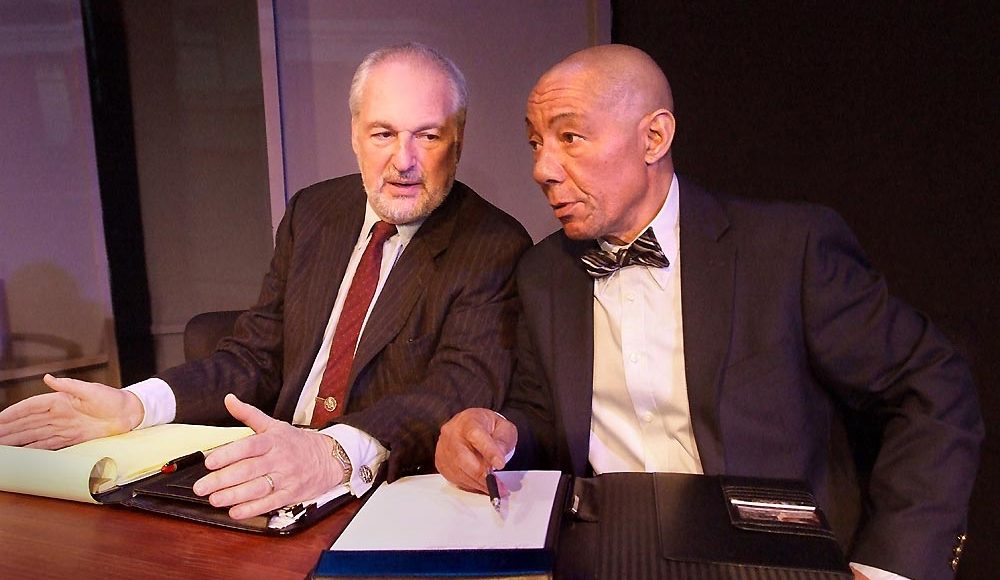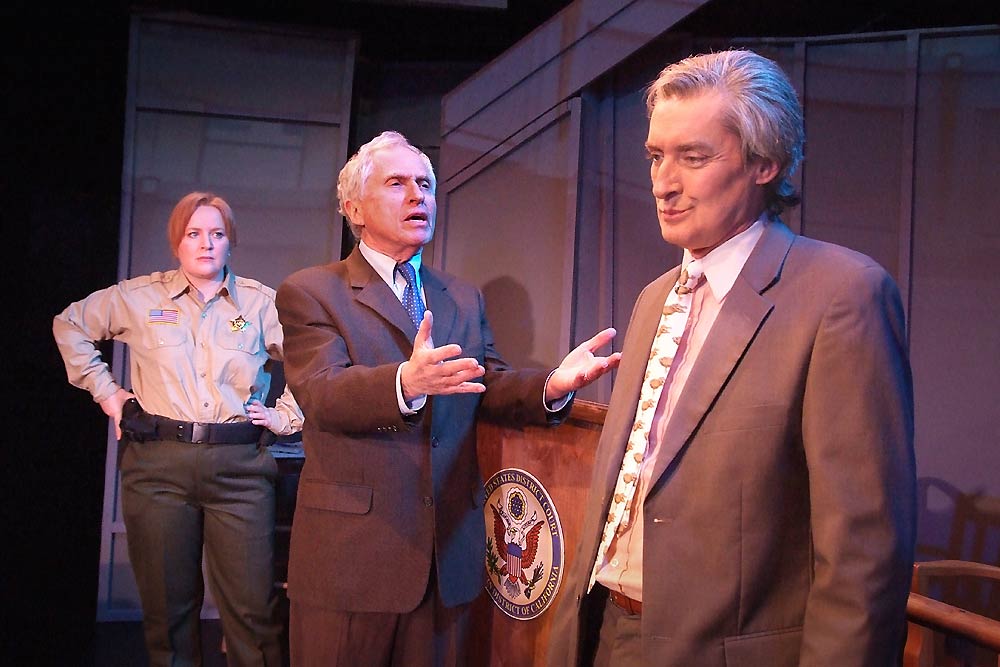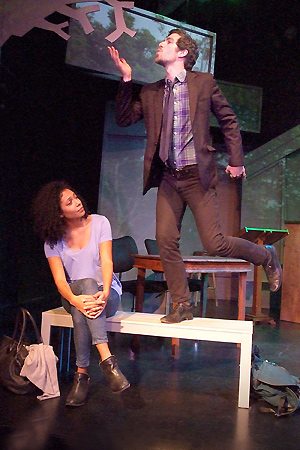Matt Chait’s Disinherit the Wind opens quite nicely, with a depiction of Bertram Cates (Chait), a neurobiologist giving a lecture on DNA before his college class. Those few enjoyable minutes, unfortunately, roll into three hours of intellectually flawed arguments, eschewed logic, cardboard characters, woeful misinterpretations of facts and a rehashing of the standard assaults on the theories of Charles Darwin that conveys all the dramatic tension and impact of a stack decked of Old Maid cards.
The plot can be fitted in a nutshell with room left over to accommodate a NordicTrack Incline Trainer. Having been dismissed for daring to challenge the holy writ of Darwinism, Cates is suing his old college cohorts (in the persons of G. Smokey Campbell and Ken Stirbl), confronting his academic nemesis (Circus-Szalewski – whose character is such a blatant “straw man” I expected him to break out with, “If I Only Had a Brain.”)
The inclusion of Cates using as his “expert witness” a former student of his (Stephen Tyler Howell)—who happens to be dating the college president’s daughter (Renahy Aulani)— wafts across the dramatic structure with the subtlety of a three-legged, blind elephant in the middle of an epileptic seizure.
Now I could compile a sizable digest of all the errors contained in Chait’s premise but let me just lob out a few and leave it at that.
Foremost is his complete falsification of the fundamental philosophy behind scientific inquiry.
“If Sir Isaac Newton were deified in the same way that Darwin is,” Cates rants during the trial, “then anyone who contradicted him would be held in contempt.”
First, a brief breakdown of the Scientific Method:
- Put forth a question (“You can get pies at a bakery.”)
- Observe and collect information (Hang around a bakery meet some bakers.)
- Form an explanatory hypothesis (You can get pies at a bakery, but not at a yoga class.)
- Test the hypothesis by performing an experiment and collecting data in a reproducible manner (try to buy pies at a number of bakeries and yoga classes)
- Analyze the data (Count the pies purchased at each location)
- Interpret the data and draw conclusions (pies, it seems, are acquired with more regularity at bakeries than yoga classes.)
- Publish results
- Retest (Start hanging around those bakeries again.)
Science is all about re-testing, re-checking, about re-examining evidence. Science advocates inquiry, investigation and thought. This in and of itself is an admission that science, unlike religion, is never perfectly satisfied with its conclusions. Science lacks the egotism of faith.
The play’s whole contention— that Darwin’s theories are somehow treated as sacrosanct—exposes Chait’s play as a fraud, or himself as ignorant of his subject. A number of Darwin views have been proven inaccurate: he was wrong about the geologic causes producing the layering shelves of Scotland’s Glen Roy Valley, his pangenesis premise and his blending inheritance theorem; all were wrong.
However, among the things Darwin got way right was his hypothesis that in order for the traits of one generation to be passed to the next, there would have to be some means of transference. Darwin realized if his assumptions were correct then this method had to exist. Today we call that method DNA.
The science of DNA did result in the most significant alternation to Darwin’s theory, when it was shown that many of an organism’s mutations do not arise from adaption to its “environment,” but are essentially genetic side effects that will be passed on if the mutation does not prove detrimental. This shifts the notion of “survival of the fittest” more towards “extinction of the least fit,” which while not negating Darwin’s primary premise, does completely sink any “argument from design.”
And finally, there are the sad facts of existence which tend to invalidate any argument for a “designer.”
There are roughly 10 to 14 million species currently sharing the earth. However over the eons, 99% of all the life forms that have existed have gone into extinction, amounting to over five billion species. Indicating if there is a designer, he certainly isn’t a very good one.
Yes, yes, I know, this shouldn’t be a dissertation on Darwin’s theory, but a review of the play. But the fact is, that the play manages to be little more than a “diatribe dressed in polemic clothing”; so, there isn’t much left to address. I know G. Smokey Campbell to be a talented actor, but even he isn’t able to pump any life into the cardboard character that Chait has provided him. Stephen Tyler Howell manages the only honest moments in this play that is largely devoid of them.
My biggest beef is not with Chait’s views, but rather with his disorganized and shoddy presentation of them. Ironically what makes Disinherit the Wind such poor theatre is exactly what makes “Intelligent Design” such remarkably bad science.
♦ ♦ ♦
Disinherit the Wind
Written by: Matt Chait
Directed by Gary Lee Reed
is playing
Fridays (8 pm), Saturdays (8pm), and Sundays (3pm) –
now through April 9
at
The Complex in Hollywood
(Ruby Theatre)
6476 Santa Monica Blvd.
Hollywood, CA 90038
(between Cole & Wilcox)
For Tickets and Additional Information
323-960-4420
Support the Voices of The TVolution. Please Subscribe and like us on Facebook.







